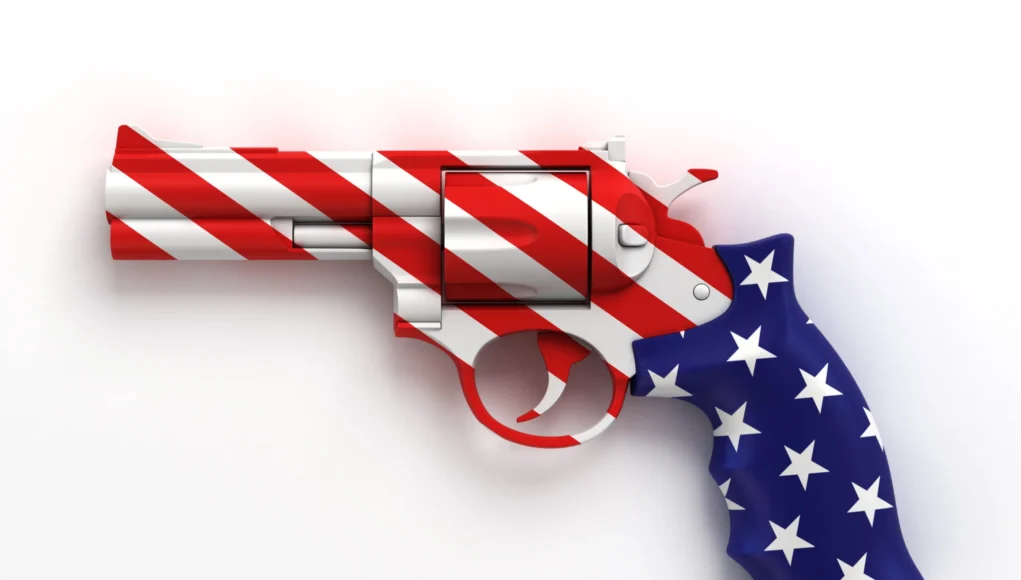No other country comes close to the level of gun ownership seen in the United States, where there are more firearms than people.
This reality is widely accepted in American politics. Both major presidential candidates and their running mates are gun owners. Even Kamala Harris, who supports more restrictive gun laws, has emphasized her commitment to the Second Amendment. In a recent interview with Oprah Winfrey, Harris stated that if someone broke into her home, “they’re getting shot.”

The comment is revealing: as Harris appeals to undecided and conservative voters, she aims to convey her understanding of the strong feelings many Americans have about gun ownership.
Naturally, Americans have diverse views on guns. The positive argument highlights the ability for self-defense and the belief that an armed populace acts as a safeguard against government tyranny. The negative perspective focuses on mass shootings and the higher rates of gun violence in the U.S. compared to other wealthy nations. After years of stalled debate, these differences can often feel exhausted.
However, this debate is narrow, only examining the immediate consequences of firearms. While these outcomes are severe and obvious, living in a country with the highest rates of civilian gun ownership also has less direct consequences, which America — perhaps due to its passion for guns — has long ignored.
Economists have a term for unintended consequences: “externalities.” The classic example is pollution. Fossil fuels power much of the world (a direct benefit), but they also emit pollutants that harm people’s health and contribute to climate change (a negative externality). To truly assess the costs and benefits of burning fossil fuels, we need to understand these externalities.
In speaking with policy experts across different fields, I found that much of the conversation about guns leaves important aspects out. Some of the United States’ most serious issues — including drugs and the economy — are influenced by the externalities associated with the production, sale, and ownership of firearms. We cannot fully understand the costs of America’s abundance of guns without considering these externalities.
The Role of Guns in Border Violence
Take, for instance, the U.S.-Mexico border — an issue that has been at the forefront of recent elections.
Illegal immigration brings guns into focus. Many migrants come to the United States to escape violence in their home countries, perpetrated by criminal groups, from major drug cartels in Mexico to street gangs in Central America, who commit such violence with impunity.
These groups are heavily armed, often able to outgun local law enforcement, thanks to the weapons they source primarily from the United States. Lax gun laws in the U.S. allow smugglers to buy firearms at gun shows or online without background checks and ship them south. More than 67 percent of criminal guns recovered in Mexico and traced by the U.S. Bureau of Alcohol, Tobacco, Firearms, and Explosives in 2021 originated in the U.S., and the actual percentage might be even higher.
American guns are “the tools of violence,” as Ieva Jusionyte, an anthropologist at Brown University, describes. “The U.S. is very much implicated in the violence in these countries.”
The influence extends further: the criminal organizations that smuggle migrants — an industry worth billions — are overwhelmingly armed with American guns and ammunition, which can be easily acquired in the U.S. but is restricted in Mexico. Dr. Jusionyte shared that when gunfire erupts across the border, U.S. border agents anticipate attempts to smuggle ammunition into Mexico, given its scarcity in legal markets there.
Guns and Drugs: A Deadly Combination
The same pattern applies to drugs. Cartels in Mexico manufacture fentanyl, methamphetamines, and other drugs for American consumers, despite decades of U.S. and Mexican government efforts to stop them. Even with significant military intervention, drugs continue to flow north, and American overdose deaths remain alarmingly high. Experts like David Shirk, a specialist in U.S.-Mexico relations, argue that “if there were no American guns, there would be a lot less Mexican fentanyl.”
Guns are not the sole cause of illegal immigration and drug trafficking — issues like poverty and inadequate addiction treatment are also factors. Yet, firearms significantly intensify these problems.
A Vicious Cycle in American Communities
Guns also contribute to other issues affecting Americans, regardless of political affiliation.
Incarceration and policing are clear examples. Research shows that more guns result in more murders, which carry severe criminal penalties and are more likely to lead to arrests and imprisonment. Some experts link America’s high number of guns to its status as one of the world’s leaders in incarceration.
Police officers, aware of how common firearms are in the U.S., are trained to expect them in virtually any situation. Compare that to officers in Japan or Britain, where firearms are rare. The fear of encountering guns makes American policing more dangerous, leading to higher rates of police shootings. This risk also contributes to the recruitment crisis in law enforcement, as fewer people are willing to enter such a dangerous profession.
Firearms also play a significant role in the worsening mental health crisis. Guns are among the deadliest means of suicide, making it more likely for someone to end their life when they attempt suicide, which is one reason why the U.S. has one of the higher suicide rates among developed nations.
The economic impact of gun violence is equally concerning. In 2015, over a quarter of gun homicides occurred in neighborhoods that make up only 1.5 percent of the population, driving out businesses, lowering property values, and diminishing public services. Yasemin Irvin-Erickson, a criminologist, notes that “how people invest in neighborhoods is very much affected by gun violence.”
All of these problems are interconnected. A community experiencing high levels of gun violence may struggle to attract businesses, leading to fewer jobs and diminished tax revenue. The lack of police officers, coupled with inadequate funding, worsens gun violence and perpetuates a vicious cycle.
An Informed Debate on Guns
It’s understandable that much of the discussion around guns centers on their immediate effects — the daily shootings and tragic mass shootings. Yet, focusing solely on these outcomes is too limited. Just as it would be irresponsible to discuss fossil fuels only by their benefits, it would be equally misleading to consider firearms without acknowledging the broader consequences.
The United States has chosen policies that make firearms easily accessible. This decision has a wide range of impacts, and all these consequences must be factored into the evaluation of gun policies.
One reason these broader consequences have been overlooked is the complexity of the issues involved, and a political system that struggles with addressing such complexity. It’s easier to focus on direct outcomes than explain how seemingly unrelated topics are connected. Furthermore, the federal government’s prohibition on using taxpayer money to fund gun research, only partially lifted in 2018, has hindered a deeper understanding of these issues.
Some Americans may look at the full costs of gun ownership and see them as justification for stricter regulations. Others, regardless of the evidence of negative externalities, may continue to support lax gun laws, believing that the benefits outweigh the downsides — whether for self-defense, deterring government tyranny, or simply for sport.
What’s important is making an informed decision. Currently, many Americans are either unaware of or ignoring some of the most significant consequences of the country’s lax gun policies. A meaningful debate on gun policy should consider all the relevant information to truly assess whether these policies are working.







































